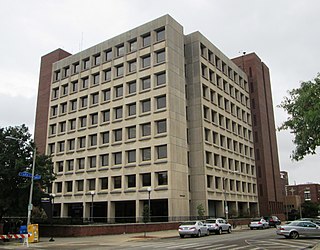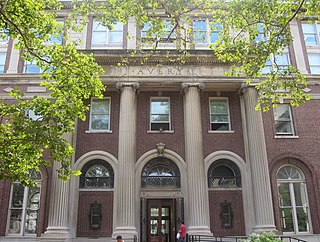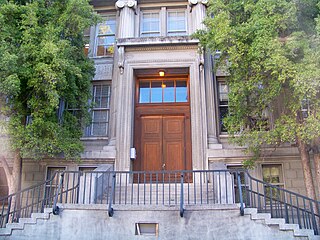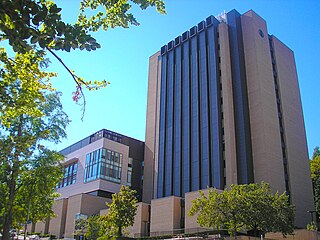
Havemeyer Hall is a historic academic building located in Columbia University in New York City.

Havemeyer Hall is a historic academic building located in Columbia University in New York City.
It was built between 1896 and 1898, under the direction of Charles Frederick Chandler and named after Columbia graduate Frederick Christian Havemeyer, a member of the Havemeyer family. [1] The building is one of six original buildings on the Morningside Heights campus in Columbia and a National Historic Chemical Landmark. [1] The Department of Chemistry of the university is based in Havemeyer Hall, and the majority of chemistry classes are taught there.
Many important experiments in the history of chemistry have been conducted in the building, as well as significant research by some of the most well known chemists of the 20th century including Marston Taylor Bogert, Henry C. Sherman, Milton C. Whitaker and John Maurice Nelson. [1] Seven individuals who researched in Havemeyer eventually received the Nobel Prize in Chemistry, including Irving Langmuir who won in 1932 for his work on surface chemistry and Harold Clayton Urey in 1934 for his discovery of deuterium. [1]
Aside from scientific and academic research, the building has appeared in several movies, in particular room 309, the grand, multi-level lecture hall designed by Charles Follen McKim. [1] Among the movies filmed there are Spider-Man , Spider-Man 2 , Spider-Man 3 , Ghostbusters , Mona Lisa Smile , The Mirror Has Two Faces , Kill Your Darlings , Malcolm X , Kinsey , Rollover and Awakenings .

Ira Remsen was an American chemist who discovered the artificial sweetener saccharin along with Constantin Fahlberg. He was the second president of Johns Hopkins University.

The UC Berkeley College of Chemistry is one of 14 schools and colleges at the University of California, Berkeley. It houses the departments of Chemistry, Chemical and Biomolecular Engineering, and Chemical Biology and occupies six buildings flanking a central plaza.

The Mellon College of Science (MCS) is part of Carnegie Mellon University in Pittsburgh, Pennsylvania, US. The college is named for the Mellon family, founders of the Mellon Institute of Industrial Research, a predecessor of Carnegie Mellon University.

The New York City College of Technology is a public college in New York City. Founded in 1946, it is the City University of New York's college of technology.

The Mellon Institute of Industrial Research is a former research institute in Pittsburgh, Pennsylvania, United States, which is now part of Carnegie Mellon University. It was founded in 1913 by Andrew Mellon and Richard B. Mellon as part of the University of Pittsburgh, and was originally located in Allen Hall. After becoming an independent research center and moving to a new building on Fifth Avenue, the Mellon Institute subsequently merged with the Carnegie Institute of Technology in 1967 to form Carnegie Mellon University. While it ceased to exist as a distinct institution, the landmark building bearing its name remains located at the corner of Fifth Avenue and Bellefield Avenue in Oakland, the city's university district. It is sited adjacent to The Carnegie Mellon Software Engineering Institute (SEI) and the University of Pittsburgh's Bellefield Hall and is across Bellefield Avenue from two other local landmarks: the University of Pittsburgh's Heinz Memorial Chapel and the Cathedral of Learning.

The College of Liberal Arts & Sciences has been central to the University of Illinois Urbana-Champaign for over 100 years. Established in 1913 through the merger of the College of Literature and Arts and the College of Science, the College of LAS now stands as the largest college at the university. The college offers several on-campus undergraduate programs, masters programs, and Ph.D. programs. As of 2020, there are nearly 12,000 undergraduate students and 2,500 graduate students attending the College of Liberal Arts & Sciences.

Henry Osborne Havemeyer was an American industrialist, entrepreneur and sugar refiner who founded and became president of the American Sugar Refining Company in 1891.

The Avery Architectural and Fine Arts Library is a library located in Avery Hall on the Morningside Heights campus of Columbia University in the New York City. It is the largest architecture library in the world. Serving Columbia's Graduate School of Architecture, Planning and Preservation and the Department of Art History and Archaeology, Avery Library collects books and periodicals in architecture, historic preservation, art history, painting, sculpting, graphic arts, decorative arts, city planning, real estate, and archaeology, as well as archival materials primarily documenting 19th- and 20th-century American architects and architecture. The architectural, fine arts, and archival collections are non-circulating. The Ware Collection, mainly books on urban planning and real estate development, does circulate.

Pupin Physics Laboratories, also known as Pupin Hall, is home to the physics and astronomy departments of Columbia University in New York City. The building is located on the south side of 120th Street, just east of Broadway. In 1965, Pupin was named a National Historic Landmark for its association with experiments relating to the splitting of the atom, achieved in connection with the later Manhattan Project. In 2009 the American Physical Society named Pupin Hall a historic site and honored Isidor Isaac Rabi for his work in the field of magnetic resonance.

The William Albert Noyes Laboratory of Chemistry, located at 505 S. Mathews Avenue in Urbana, Illinois, United States, on the campus of the University of Illinois at Urbana-Champaign, was built in 1902 as the "New Chemical Laboratory", and was designed by Nelson Strong Spencer in the Richardsonian Romanesque style. The Chemistry Department had been founded in 1867, and in 1878 moved into a building of its own, the first department of the university to do so. When the department outgrew that building, department head Arthur W. Palmer convinced the state legislature to build a new lab, with 77,884 square feet of usable space, at the cost of under $100,000.

The National Historic Chemical Landmarks program was launched by the American Chemical Society in 1992 to recognize significant achievements in the history of chemistry and related professions. The program celebrates the centrality of chemistry. The designation of such generative achievements in the history of chemistry demonstrates how chemists have benefited society by fulfilling the ACS vision: Improving people's lives through the transforming power of chemistry. The program occasionally designates International Historic Chemical Landmarks to commemorate "chemists and chemistry from around the world that have had a major impact in the United States".
The University of Mississippi School of Engineering was officially established in 1900 as part of the University of Mississippi in the U.S. state of Mississippi. In 1854 the Board of Trustees established a department of engineering at the University of Mississippi to complement a strong program in the natural sciences. It is considered the oldest school of engineering in the state of Mississippi.

Charles Holmes Herty Sr. was an American academic, scientist, and businessman. Serving in academia as a chemistry professor to begin his career, Herty concurrently promoted collegiate athletics including creating the first varsity football team at the University of Georgia. His academic research gravitated towards applied chemistry where he revolutionized the turpentine industry in the United States. While serving as the president of the American Chemical Society, Herty became a national advocate for the nascent American chemical industry and left academia to preside over the Synthetic Organic Chemical Manufacturers' Association (SOCMA) and the Chemical Foundation. He was also instrumental in the creation of the National Institutes of Health. Towards the end of his career, Herty's research and advocacy led to the creation of a new pulp industry in the Southern United States that utilized southern pine trees to create newsprint.

Gilman Hall is a building on the campus of the University of California, Berkeley. Room 307 was where Glenn T. Seaborg and his coworkers identified plutonium as a new element on February 23, 1941 and as such, is designated a National Historic Landmark. The building itself is designated a National Historic Chemical Landmark, recognizing the two Nobel Prizes in Chemistry that have resulted from research done in the building.

Allen Hall at the University of Pittsburgh is a Pittsburgh History and Landmarks Foundation Historic Landmark and a contributing property to the Schenley Farms National Historic District. Completed in 1914 and originally serving as the home to the Mellon Institute of Industrial Research, the six story Greek Revival building designed by J. H. Giesey now serves as the home of the university's Department of Physics and Astronomy.

Chevron Science Center is a landmark academic building at 219 Parkman Avenue in Pittsburgh, Pennsylvania, United States on the campus of the University of Pittsburgh. The 15-story facility, completed in 1974, was designed by Kuhn, Newcomer & Valentour and houses the university's chemistry department. A three-story addition above Ashe Auditorium was completed in 2011.

Charles Frederick Chandler was an American chemist, best known for his regulatory work in public health, sanitation, and consumer safety in New York City, as well as his work in chemical education—first at Union College and then, for the majority of his career, at Columbia University, where he taught in the Chemical Department, the College of Physicians and Surgeons, and served as the first Dean of Columbia University's School of Mines.

The Yard is one of the main quadrangles on the campus of Howard University in Northwest Washington, DC. The Yard is the principal open space at the northern end of the academic portion of the campus, flanked by nine academic buildings. It is the site of a variety of campus gatherings, most notably its annual Homecoming festivities, which are known as "Yardfest". The quadrangle and three buildings, Andrew Rankin Memorial Chapel, Frederick Douglass Memorial Hall, and Founders Library, are a listed National Historic Landmark, important for their role in the advancement of civil rights in education during the 20th century.
Eastern Michigan University College of Arts and Sciences is one of the Colleges at Eastern Michigan University. Today there are more than 125 programs of study in the College of Arts and Science. The College of Arts and Sciences oversees the largest number of academic facilities and is the largest college at EMU.

The Princeton University Department of Chemistry is an academic department at Princeton University. Founded in 1795, it is one of the oldest departments of chemistry in the country and is consistently funded by grants from the National Science Foundation and the National Institutes of Health. In 2010, the department moved to its new location, the Frick Chemistry Laboratory. The department oversees the undergraduate, graduate, and post-doctoral programs in chemistry, as well as a number of research centers and initiatives at the university.